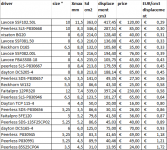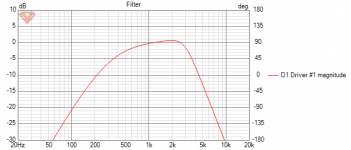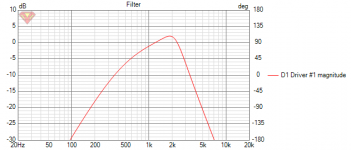250-2500 Hz for analog phone, 300-3000 Hz for digital, so for their ~universal PA driver the pioneers used an 8" frame and designed a one piece three way (mechanical XO/tri-ax) driver (W.E. 755) and last I auditioned one it was still the best to my ears, but that's been decades now and such a high priced collectible that I doubt I'll ever get another chance. 🙁 Sorry, ATM can't remember the XO points. 🙁
For high power cinema/PA they ultimately settled on a two way horn system @ 500 Hz as the best overall compromise with 800 Hz for small cinema, etc., and only in recent decades due to wider BW THX soundtracks broken it down further.
Regardless, call me old fashioned, but even though our 'sounds' are all digital now, designing based on how we hear, i.e. optimizing the analog BW makes the most sense to me.
For high power cinema/PA they ultimately settled on a two way horn system @ 500 Hz as the best overall compromise with 800 Hz for small cinema, etc., and only in recent decades due to wider BW THX soundtracks broken it down further.
Regardless, call me old fashioned, but even though our 'sounds' are all digital now, designing based on how we hear, i.e. optimizing the analog BW makes the most sense to me.
I was going through the messages again.the sp4-60 is quite big for a 4", mid-surround-to-mid-surround diameter is 95 mm.
you just have to accept (or cover) the somewhat ugly foam-gasket-front.
I have this driver at home, waiting for implementation in a 3-way. let me know if you want pictures or dimensions.
also have a look at the implementation in this 4-way-project.
The monacor SP4-60 looks like a great driver. What would stop me from buying is the foam-gasket front.
Do you have any idea how you can cover it? How much space you have to work with? Also what is the best way to screw it onto the baffle?
Im sure there are some options but not sure what is possible. 🤔
Did you already have a candidate for your woofer in the 3-way you want to build?
I'm not sure where you live but I wish I had bought my SB12MNRX2-25-4 for $42.00 each. I looked at the Monacor and it looks like a stamped steel basket vs. the cast frame on the SB. Also, I could not find a US distributor, this is moot if you live in the EU.I was going through the messages again.
The monacor SP4-60 looks like a great driver. What would stop me from buying is the foam-gasket front.
Do you have any idea how you can cover it? How much space you have to work with? Also what is the best way to screw it onto the baffle?
Im sure there are some options but not sure what is possible. 🤔
Did you already have a candidate for your woofer in the 3-way you want to build?
https://www.madisoundspeakerstore.c...b12mnrx2-25-04-4-midrange.-4-ohm-new-version/
i suppose best way is to make a circular metal sheet ring with holes for screws, round and black and slightly bigger than the basket. i will do it this way. i will countersink the driver and the ring and mount the driver plus metal sheet flush with the baffle, see my sketch. the dimensions on the drawing should be more or less correct 🙂.Do you have any idea how you can cover it? How much space you have to work with? Also what is the best way to screw it onto the baffle?and it looks like a stamped steel basket
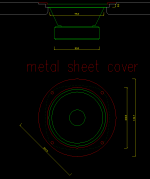
another example here!
as a first test i tried to mount the driver flush in an existing 2-way baffle... not the easiest basket to route, but i admit my jig was a bit sloppy:
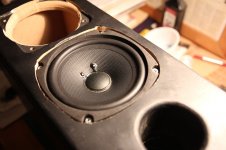
not really, but I am considering a LAVOCE 10 inch "subwoofer". again, with a foam gasket front...Did you already have a candidate for your woofer in the 3-way you want to build?
yes, it's a steel basket, but keep in mind it's ridicously cheap at 24 EUR/piece (soundimports).looks like a stamped steel basket
Last edited:
Well... I cross my MW13TX at 2kHz to a Seas DXT, to have a smooth and even transition between the two. Also, this gives me a good even dispersion, so that the sound does not change in level, even off-axis(reflections). I find this to give me a much more neutral and focused stereo image, with fewer annoyances from the room.😄
So to the collective wisdom on this thread...
I often read that 300 to 3k or so is good for the midrange as it covers all the 'important telephone band' with one driver. But now I read that most of the power in music is around 300 and so that is better handled by a bigger driver crossing to the mid 500 or so.
And also that the mid maybe better off at 3" or so.
Just 2 different trains of thought I guess, each with their own compromises?
If you cross a midrange to any normal direct firing tweeter at around 3kHz - I can't imagine it being a good solution. The tweeter will spread in a full 180 degree pattern, with an uneven power level match to a midrange that most surely will have started to beam.
I, those the MW13, because it made it much easier to be sure that I would have a smooth low-pass filter towards the tweeter, at all axis'. Further, I cross at 450Hz from two SB23NRX - which I might consider changing into two Satori WO24P-8, so that even fewer breakup modes can "color" this frequency area - and maybe result in an even more smooth transition.
I also use subwoofers, which make me care way less of how deep my woofers can play. Right now, everything below around 110Hz is handled by two 12" and two 15". The two 8" SB's simply roll off slowly under 100hz... to blend more easily with subwoofers, creating way less phase issues and problematic dips and peaks.
Most 4-5" midrange are pretty good - even the less expensive ones. My advice would be to look deeper into dispersion/off-axis, remember to have a good woofer to fill in under the midrange and find a smooth tweeter that integrates well with the off-axis of the midrange - often - cross a bit lower.
I was thinking in the same line. It does mean some metal work (which I dont have tools for ) and extra cost which take away the advantage of this driver I guess, because it really is good value for money.i suppose best way is to make a circular metal sheet ring with holes for screws, round and black and slightly bigger than the basket. i will do it this way. i will countersink the driver and the ring and mount the driver plus metal sheet flush with the baffle, see my sketch. the dimensions on the drawing should be more or less correct 🙂.
View attachment 1021036
another example here!
Also will have sidewall of the thinkness of the metal surround. I dont know the accoustical influence of that.
Foam gasket for woofer is less of a problem. Any reason why you choose this one? It is very sensitive but higher fs.as a first test i tried to mount the driver flush in an existing 2-way baffle... not the easiest basket to route, but i admit my jig was a bit sloppy:
View attachment 1021035
not really, but I am considering a LAVOCE 10 inch "subwoofer". again, with a foam gasket front...
crossing @ 300 and 3K is flexible depending on the drivers and how they cross best.Well... I cross my MW13TX at 2kHz to a Seas DXT, to have a smooth and even transition between the two. Also, this gives me a good even dispersion, so that the sound does not change in level, even off-axis(reflections). I find this to give me a much more neutral and focused stereo image, with fewer annoyances from the room.
If you cross a midrange to any normal direct firing tweeter at around 3kHz - I can't imagine it being a good solution. The tweeter will spread in a full 180 degree pattern, with an uneven power level match to a midrange that most surely will have started to beam.
I, those the MW13, because it made it much easier to be sure that I would have a smooth low-pass filter towards the tweeter, at all axis'. Further, I cross at 450Hz from two SB23NRX - which I might consider changing into two Satori WO24P-8, so that even fewer breakup modes can "color" this frequency area - and maybe result in an even more smooth transition.
I also use subwoofers, which make me care way less of how deep my woofers can play. Right now, everything below around 110Hz is handled by two 12" and two 15". The two 8" SB's simply roll off slowly under 100hz... to blend more easily with subwoofers, creating way less phase issues and problematic dips and peaks.
Most 4-5" midrange are pretty good - even the less expensive ones. My advice would be to look deeper into dispersion/off-axis, remember to have a good woofer to fill in under the midrange and find a smooth tweeter that integrates well with the off-axis of the midrange - often - cross a bit lower.
300Hz was choosen because of the baffle width of around 36cm.
At the moment, following drivers are concidered.
closed box ; SB26ADC ; SB12MNRX2 ; SB23NRX
I think it is possible to cross tweeter and mid @3k.
Any thoughts are most welcome
Attachments
That's a great price. Im from Europe but cheapest is 50 euro.I'm not sure where you live but I wish I had bought my SB12MNRX2-25-4 for $42.00 each. I looked at the Monacor and it looks like a stamped steel basket vs. the cast frame on the SB. Also, I could not find a US distributor, this is moot if you live in the EU.
https://www.madisoundspeakerstore.c...b12mnrx2-25-04-4-midrange.-4-ohm-new-version/
extra cost which take away the advantage of this driver
that is true, of course.
the foam gasket can be compressed or eventually be cut to avoid the metal sheet obstructing sound propagation.
mainly I am interested in these cheap and quite unknown drivers. but there is still plenty of time to change my mind ...Any reason why you choose this one? It is very sensitive but higher fs.
edit: attached a quite arbitrary list of drivers in order of cost per displacement (EUR/cm3), lowest cost per displacement on top.
Attachments
Last edited:
You could also end up crossing at 358Hz and 2319Hz. It has a lot to do about how it measures. Be careful to look to blindly on fixed numbers - but if it works - it works. Crossing a little lower is very easy with an Aguerpro waveguide, which the SB26ADC fits perfectly for. You could also choose the SB26CAC, SB12CAC and SB23CAC for a different look - like the Revel.crossing @ 300 and 3K is flexible depending on the drivers and how they cross best.
300Hz was choosen because of the baffle width of around 36cm.
At the moment, following drivers are concidered.
closed box ; SB26ADC ; SB12MNRX2 ; SB23NRX
I think it is possible to cross tweeter and mid @3k.
Remember that the drivers might do all sorts of fun stuff, when mounted in a given baffle, with a given distance to the sides. The cool thing about the Augerpro waveguide is, that is seems to have freed itself from the frontbaffle - in that sense that it measure well even in a simple front. My DXT needs a pretty steeply slanted front along the driver, to make it work well.
Yes absolutely. If it works best with 358Hz and 2319Hz then that's what it will be.You could also end up crossing at 358Hz and 2319Hz. It has a lot to do about how it measures. Be careful to look to blindly on fixed numbers - but if it works - it works. Crossing a little lower is very easy with an Aguerpro waveguide, which the SB26ADC fits perfectly for. You could also choose the SB26CAC, SB12CAC and SB23CAC for a different look - like the Revel.
Remember that the drivers might do all sorts of fun stuff, when mounted in a given baffle, with a given distance to the sides. The cool thing about the Augerpro waveguide is, that is seems to have freed itself from the frontbaffle - in that sense that it measure well even in a simple front. My DXT needs a pretty steeply slanted front along the driver, to make it work well.
I just looked at the off axis of both drivers and assumed that 3K is possible.
I want to work with low order XO as well. These drivers look smooth enough to do that.
I'm not into hard drivers (anymore) I had them for long time but came to a point that I dont want to reveal the latest bit of detail. I rather reveal a bit more music, if that makes sense.
I want to start without waveguide. Maybe later I can add one.
I agree, actually. I used 5" Accuton midranges and Seas Excel Magnum for years and loved the combo - but simply found that getting them to "sing" was to get the filter and the layout of the baffle right.Yes absolutely. If it works best with 358Hz and 2319Hz then that's what it will be.
I just looked at the off axis of both drivers and assumed that 3K is possible.
I want to work with low order XO as well. These drivers look smooth enough to do that.
I'm not into hard drivers (anymore) I had them for long time but came to a point that I dont want to reveal the latest bit of detail. I rather reveal a bit more music, if that makes sense.
I want to start without waveguide. Maybe later I can add one.
I bought a set of SB26ADC along with the MW13TX to see if the Augerpro really perform as good as the Seas DXT, mayby better., when the cabinet is done right. And the ADC is a hard cone too... so I thought I'd get a mix with the Textreme, since for me - hard cones do something special, that soft cones just can't 😉
My annoyance is mostly in the woofer range, where the room and slight errors in the filter, easily makes this annoying ringing in some recordings. You could - as you point out - use less detailed drivers - softer paper do tend to lose detail - I agree. But I believe it's also a matter of taste and experience. Which is why it is great that we have so many great performing drivers out there.
I think 3kHz is high... but if you make it work - rock on 👍😎
Why you have a feeling that 3K is too high?I think 3kHz is high... but if you make it work - rock on 👍😎
Just trying to learn and understand.
From what I see, distortion is low from 2k onwards for tweeter.
Dispersion from tweeter and mid's seems to match.
Dont know what else come into the picture to decide on XO point.
Goal is to land somewhere around the 2K8 mark.
troels crossed it @ 3k7
http://www.troelsgravesen.dk/SBAcoustics-3WC.htm
Last edited:
I can't be sure... but it seems that he only measures out to 30 degrees, and already here, it starts to look a lot different from on-axis. It might sound fine, but I'm just a type that go's further to get a really smooth transition, like within +/-2dB. Again, this might be splitting hairs for some... but it might be enough. I just find that I can hear pretty precise tuning withing 1-2dB - which is why I try to find crossovers and drivers where I can obtain this.Why you have a feeling that 3K is too high?
Just trying to learn and understand.
From what I see, distortion is low from 2k onwards for tweeter.
Dispersion from tweeter and mid's seems to match.
Dont know what else come into the picture to decide on XO point.
Goal is to land somewhere around the 2K8 mark.
troels crossed it @ 3k7
http://www.troelsgravesen.dk/SBAcoustics-3WC.htm
Thanks for your view.I can't be sure... but it seems that he only measures out to 30 degrees, and already here, it starts to look a lot different from on-axis. It might sound fine, but I'm just a type that go's further to get a really smooth transition, like within +/-2dB. Again, this might be splitting hairs for some... but it might be enough. I just find that I can hear pretty precise tuning withing 1-2dB - which is why I try to find crossovers and drivers where I can obtain this.
I want to get the best possible of course. If it means lowering XO then so be it.
When I look the manufacturers graph, both tweeter and mid are +-2db down @ 3K. It doesnt look so different compared to 2K.
Lower XO suits the mid-driver I guess, because of the distortion peak @7K but many not the tweeter.
3K is just a guestimate from my side.
Oh... I think I see where it might make a bigger difference. I use 24LR filters, and if you use 12dB filters, then some drivers might complain a little when pushed. And since I run active, I often sense a different approach than when trying to build passive - which I actually never tried 🙂
I did a simulation with a textbook 8 ohm driver and textbook filters to show what happens to a passive bandpass filter. If the low pass and high pass elements are to close in frequency they will interfere with each other and get unexpected results. The old text books tell us to make the low pass frequency to 8 to 10 times higher than the high pass. That's where the 300 3000 numbers come from. For the high pass I'm using a Linkwitz–Riley 2nd order and for low pass I'm using a Butterworth 3rd order, not unusual. Here are schematics and filter responses for a 300 3000 band pass and 500 2200. Compare the filter shapes and you will see what I was trying to point out. DSP solutions might not have this problem but passive crossovers do.Oh... I think I see where it might make a bigger difference. I use 24LR filters, and if you use 12dB filters, then some drivers might complain a little when pushed. And since I run active, I often sense a different approach than when trying to build passive - which I actually never tried 🙂
Attachments
A good example of why using textbook filters and arbitrarily chosen crossover points is not a good way to design a speaker. The only difference between active and passive in your example would be if the impedance of the drivers was causing an interaction with the passive elements to give something other than the intended slope.
Your point is a good one but not the one I was trying to make. My point was that a passive bandpass should be 3 or more octaves wide or the two filters will interact. Of course textbook drivers and filters are a waste of time, but by using them I could illustrate why not to make a narrow bandpass filter as I thought was suggested earlier in the thread.A good example of why using textbook filters and arbitrarily chosen crossover points is not a good way to design a speaker. The only difference between active and passive in your example would be if the impedance of the drivers was causing an interaction with the passive elements to give something other than the intended slope.
For sure they will but not just for passive ones, low slope crossovers have an impact over a really wide frequency range.My point was that a passive bandpass should be 3 or more octaves wide or the two filters will interact.
Here is an example by using 2nd order filters at 500 Hz and 2500Hz there doesn't look to much untoward in the shape of the bandpass but it results in a 1dB dip at the mid point. Extending the bandpass to 250 and 3000 gives a flat result. The dip is easy enough to fix with either active boost/cut or resistors, and in some cases it might be useful to bring down a mid that was more sensitive.
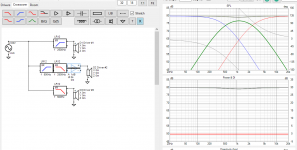
- Home
- Loudspeakers
- Multi-Way
- Which MID for 3-way system : SB12MNRX2-25-4 or Visaton B 80, 8 ohm
